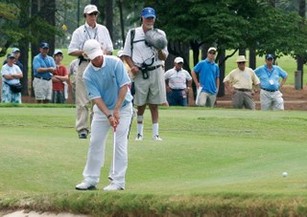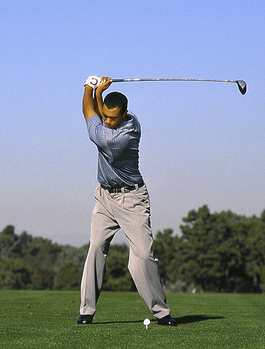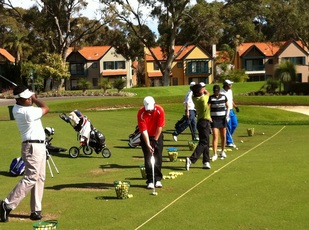WA Golf: Pro Tour Golf College Student Whitney Hillier is Undefeated in the Gladys Hay Memorial Cup22/9/2011
Last week the Gladys Hay Memorial Cup (Womens Interstate Series) was contested at the Western Australian Golf Club, Mt Yokine with womens golf teams from every state of Australia playing for the famous cup which hasn't been won by W.A since 2005. This year they won the series in convincing fashion beating New South Wales in the hotly contested final.  WHITNEY THE GOLF WARRIOR The good news is that Whitney Hillier who is a long time student of David Milne - co-director of Pro Tour Golf College went through the series undefeated which was a fantastic effort on her part. David had suggested to Whitney that training at PTGC would sharpen her golf skills and really increase her confidence going into this important event on the Australian amateur golf calender and this proved to be great advice. We're really happy for Whitney and the W.A team and considering that not that long ago Whitney had a career threatening wrist injury that was going to short-change her golfing future it is wonderful to see her back competing and winning. Well done Whitney you're an inspiration to everyone at Pro Tour Golf College. Pro Tour Golf College and the Indonesian National Golf Team played a friendly match today at Meadow Springs Golf and Country Club in Mandurah about and hour and a half south of Perth. It was a warm day with perfect playing conditions and some excellent golf was played by both sides over 18 holes.
The best score on the day was achieved by two of our students at Pro Tour Golf College Bramantio Adi (Ibam) and Grant Roger with 75's. On the Indonesian team Rinaldi Adiyandono was the best of the Indonesian team also with a 75. After the 18 hole match and some lunch the players went back to the practice fairway and shortgame area to practiced the routines we had designed for them using the excellent facilities at Meadow Springs. At 5pm we wrapped up and headed back to Joondalup and arrived at 6.30. A solid 12 hour day that everyone enjoyed with another big day tomorrow. Lawrie and David Pro Tour Golf College welcomes the Indonesian National Golf Team to Pro Tour Golf College this week. Fresh from a recent tournament in Hong Kong the team is attending the college in preparation for the South East Asian Games in Jakarta in November.
The team will be training with us for a bit over a week here in Australia and then David and I will be working with them in Indonesia. So far the team has enjoyed training our way and have been surprised at the structure of the training and emphasis on lowering golf scores and increasing confidence. Today they went through a comprehensive putting assessment hitting over two hundred putts from four angles to the hole. Then they hit approach wedge shots, greenside shots and finally full shots from 80 metres to 180 metres. After the training they played nine holes which rounded off a solid 8 hours of training. We know that they will gain a great deal from their golf training experience at PTGC and David and I have no doubt that they will gain new knowledge and skills in how to lower their golf scores and become more competitive. Lawrie and David  It’s so easy to get sucked into the illusion that the golfers you watch on TV who are a gazillion under par in a tournament somehow play like that all the time and have a special talent that other golfers do not have. Nothing could be further from the truth. What they do have that week is the ability to make a lot of birdies and not a lot of bogeys. Skilful yes, talented no. Great golfers are made not born. It’s convenient for commentators to use the word “talented” to describe someone’s exceptional performance on the golf course, and golf commentators use this superlative phrase all the time. Here’s an important point to consider. You can call anyone talented when it’s after the fact!  For instance; pro tour guy hit’s a five iron from two hundred yards next to the hole with a tight pin placement and the commentator say’s “wow look at that shot, this guy’s talented.” One exceptional golf shot next to the hole and he earns the elevated status of “talented.” Have a good look at the competitive score average of a top tour golfer for a full season and you’ll discover a sobering reality. Their scoring average is nowhere near their best weeks score average. Don’t get me wrong these guys and gals are really good golfers. They couldn’t make it to the PGA or LPGA tour if they weren’t. They do score exceptionally well most of the time and beyond that sometimes. But the facts are that if a tour pro’s competitive score average is 71.0 for the year and he’s 12 under par standing on the eighteenth tee in the fourth round you can be absolutely sure that he doesn’t do that every week. Based on his average he should shoot around four under par for four rounds. So once, maybe twice in a year pro tour golfers “play their heads off” and play a lot better than their score average and make it to your TV screen. Remember TV people are not showing you the guys and gals who are ten or more shots from the lead. These golfers are playing really well too, but closer to their score average and not at the stratospheric levels of the leaders, so they don’t make the grade and make it to your TV. They’re not exciting enough and not making enough birdies this week. The fantasy that many golfers are sucked into is that only a select few can play like these “golfing immortals” that are somehow blessed with a special low scoring “talent.” Wrong, wrong and wrong!  It’s true that to win on pretty much any professional golf tour you will have to play well under par for four rounds. However it’s not a special talent that you need to possess but an exceptional set of highly practiced and developed golf skills (that any amateur or professional golfer can learn) that allow you to set up lower golf scores. These skills are known to virtually everyone playing the game of golf, and are mentioned in countless golf books, golf magazines and yes even on TV; and yet they are not practiced nearly as much as they should be because the ambitious golfers (who are failing to make the grade) tend to be more concerned with whether their golf swing looks and functions correctly. Sad as it is to say, many of these ambitious golfers don’t spend nearly enough time practicing these low score “money making” skills. In pro golf the approach wedges from twenty metres to one hundred metres from the green (22 yards to 110 yards) and all the shots within twenty metres (22 yards) of the green like chip shots, pitch shots, lob shots, bunker shots and trouble shots are the low score skills. On the putting green the most important putts are from four metres and closer (13 to15 feet) and the long putts from fifteen metres to thirty metres (50 to 100 feet). Any ambitious golfer mastering these specific skills can become an exceptional golfer.  Strangely what’s difficult to understand is that in my experience these golfers know how important these skills are and that improvement in them would significantly improve their performances on the golf course but they choose to practice and take lessons on their full swing much more often? Why? I believe the answer underpinning this question is that the culture of golf still tends to equate great golf performance to a great golf swing. That’s right; the majority of commentary about exceptional golf performances is focused on the quality of a golfer’s technique more than how many putts they’re having, or how many of their approach wedges they hit to within six feet of the hole. Short-game skills simply aren’t sexy compared to a golf stars golf swing technique. It’s almost like golfers are addicted to discovering the soul of the golf swing so they can have it too. The sad reality is that a golfer’s swing style rates much higher than how skilful a golfer is around the greens. A golfer who possesses a great golf swing and ball striking ability (in the eyes of the experts) is described by commentators as a talented ball striker. If he hits a shot close to the hole the commentator links the shot to the word talent and if he wins or performs well that week he will probably end up with a full swing sequence in a leading golf magazine the next month.  This version of golf isn’t consistent with what the raft of research by Benjamin Bloom, Karl Anders Ericsson and others have discovered about what it takes to become an exceptional performer at golf. The research suggests that outstanding performers without exception have practiced intensively under highly experienced and knowledgeable golf instructors, and that the quality and quantity of their practice over a long time were critical factors in how much success they experienced. Great golfers are made, and outstanding performers in golf are the product of literally thousands of hours of highly specific golf training with exceptional coaching support over many years. Contrary to expert (and popular) opinion it’s not because a golfer is more “talented” or “gifted” than someone else that is reason they shoot very low golf scores, it’s a special kind of hard work beyond your level of comfort and competence that makes you exceptional at golf. So how about we give the word talent a rest and call it what it really is. Lawrie Montague |
Archives
June 2019
|
Proudly Supported By
Copyright © 2011 - 2018 Pro Tour Golf College
Website Managed By Golf Performance Media
All Rights Reserved
Website Managed By Golf Performance Media
All Rights Reserved




 RSS Feed
RSS Feed



